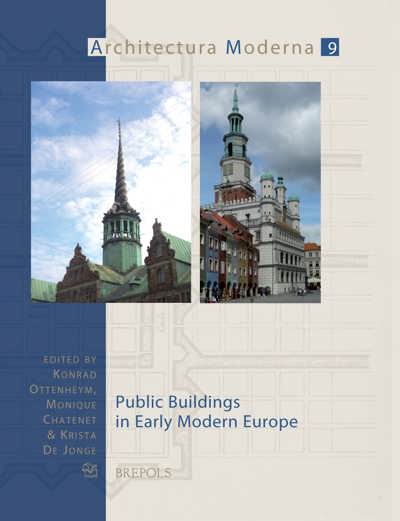
Building the Presence of the Prince
The Institutions Responsible for the Construction and Management of the Buildings of European Courts (14th-17th centuries)
José Eloy Hortal Munoz, Merlijn Hurx (eds)
- Pages: 344 p.
- Size:216 x 280 mm
- Illustrations:28 b/w, 73 col., 25 tables b/w.
- Language(s):English
- Publication Year:2025
- € 109,00 EXCL. VAT RETAIL PRICE
- ISBN: 978-2-503-59336-4
- Paperback
- Available
- ISBN: 978-2-503-59337-1
- E-book
- Available
The relevance of the building administration in the shape of the image of the Early Modern rulers
José Eloy Hortal Muñoz is Professor of Early Modern History at the University Rey Juan Carlos in Madrid since 2009. His main research interests are the political history of the Habsburg Netherlands in the sixteenth and seventeenth century, and particularly the Courts of Brussels and Madrid, the royal guards of the Spanish Habsburgs and, currently, the Royal Sites (Reales Sitios) during Habsburg times. His major works include the monographs Las guardas reales de los Austrias hispanos (Madrid, 2013); Los asuntos de Flandes. Las relaciones entre las Cortes de la Monarquía Hispánica y de los Países Bajos durante el siglo XVI (Saarbrücken, 2011); and (with Gijs Versteegen) Las ideas políticas y sociales en la Edad Moderna (Madrid, 2016).
Merlijn Hurx is professor of Architectural History at KU Leuven. He specialises in medieval and early modern architecture in the Low Countries and is PI of the ERC-funded project URBAN-DELTA. Building Metropolises in the Mud, which investigates innovation in delta building technology in Europe and China in the pre-industrial age.
By the late Middle Ages, architecture became an increasingly important means of representation of princely rule and institutions. In addition to their symbolic significance, the ruler’s buildings served a host of practical purposes. Obviously, castles and fortresses defended the territory, while urban and rural residences served the itinerant court during its proceedings, but their possessions also comprised a wider network of estates that included infrastructure and agricultural, commercial, industrial, and administrative buildings. Together, these networks of sites became a significant means of consolidating the sovereigns’ power and served as key instruments for promoting their rule. To tighten the control over their possessions and to ensure their upkeep, rulers set up Offices of Works, permanent administrative bodies entrusted with their management.
These building administrations have not yet been systematically studied, and it remains unclear to what extent such centralised institutions developed autonomously, responding to local conditions and requirements, or were part of international developments facilitated by the close networks of the European courts.
This volume, with contributions from architectural historians, administrative historians, and court historians, represents a first attempt to compare these institutions on a pan-European scale from the late Middle Ages up to the end of the seventeenth century. It aims to explore the relationships between the local specificities of these organisations and their shared characteristics. From a multidisciplinary perspective, it addresses questions concerning the nature of such administrations, their purpose, organisational structure, and judicial powers, as well as their role in the formation of the state.
Acknowledgements
1. Introduction
José Eloy Hortal Muñoz and Merlijn Hurx
Part I. Administrative Reforms and Procedures
2. The Management of Buildings in the Duchy and County of Burgundy at the Time of the Valois Dukes
Hervé Mouillebouche
3. The Brabantine ‘Office of Works’ and the Centralisation of Burgundian Administration
Robert Stein
4. Centralisation and Decentralisation in Burgundian Building Administrations in the Low Countries
Merlijn Hurx
5. The Prague Castle Bauordnung of 1557: Context, Conditions, Outcome
Sarah Lynch
6. Building for the High Nobility in the Low Countries: the Architectural Project Management of Charles of Croÿ (1560-1612)
Sanne Maekelberg
7. Power, Environment and Territory: the Creation and Implementation of Royal Forestry Legislation and Administration in Portugal from a Mediterranean Perspective (14th-17th centuries)
Koldo Trápaga
8. The Administration and Funding of the Royal Sites of the Spanish monarchy during the Sixteenth and Seventeenth Centuries: The Junta de Obras y Bosques
Félix Labrador Arroyo
Part II. Architects and Administrators
9. Building for a Royal Prince around 1400: the Case of Jean de Berry
Thomas Rapin
10. Managing Royal Buildings in Mediaeval and Early Modern Portugal
Nuno Senos and Hélia Silva
11. The Early Development of Princes´ Building Administrations in the Holy Roman Empire (16th-17th Centuries)
Anna-Victoria Bognár
12. Building the Palaces of Frederik Hendrik, Prince of Orange: the Nassau Estates’ Council, Its Architects and Its Building Contractors (1625-47)
Konrad Ottenheym
13. Between Tradition and Evolution: The Superintendence of the King’s Buildings in the Era of Hardouin-Mansart
Benjamin Ringot
Part III. Representing the Prince
14. The Functions of the Institutions Responsible for the Ruler´s Works: Princely (Royal) Geographies as an Instrument for Princely Rule
José Eloy Hortal Muñoz
15. Royal Ambition and the Stuart Office of Works 1604-49
Simon Thurley
16. Fracturing or Strengthening the Royal Presence: Dynasticism and Royal Places in Early Modern Sweden
Fabian Persson
17. Palaces and Royal Places where no Kings Lived: Royalty in the Viceroyalties
Manuel Rivero Rodríguez
18. Conclusions
José Eloy Hortal Muñoz and Merlijn Hurx
Index of Names
Index of Princely Sites and Geographies




